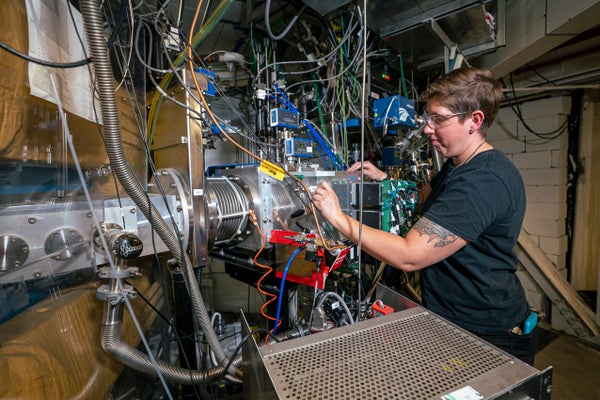
New Superheavy Element Synthesis Points to Long-Sought ‘Island of Stability’
A novel way of making superheavy elements could soon add a new row to the periodic table, allowing scientists to explore uncharted atomic realms

Jacklyn Gates, head of the Heavy Element Group at Lawrence Berkeley National Laboratory in California, is leading an effort to create the superheavy element 120.
Marilyn Sargent, Multimedia Prod/The Regents of the University of California, Lawrence Berkeley National Laboratory
For new, human-made heavy elements on the periodic table, being “too ‘big’ for your own good” often means instability and a fleeting existence. The more protons and neutrons scientists squeeze together to construct a “superheavy” atomic nucleus—one with a total number of protons greater than 103—the more fragile the resulting element tends to be. So far all the superheavy elements humans have managed to make decay almost instantaneously. Researchers who synthesized such hefty atoms via a particle accelerator at the Lawrence Berkeley National Laboratory, however, have now made a significant stride toward the elusive “island of stability”—a hypothesized region of the periodic table where new superheavy elements might finally endure long enough to buck the trend.
The team successfully forged element 116, livermorium, using a novel method involving titanium 50, a rare isotope that makes up about 5 percent of all the titanium on Earth. By heating this titanium to 3,000 degrees Fahrenheit and channeling it into a high-energy beam, the researchers were able to blast this particle stream at other atoms to create superheavy elements. Although livermorium has been made before using other techniques, this innovative approach paves the way for the synthesis of new, even heavier elements, potentially expanding the periodic table.
“This achievement is truly groundbreaking,” says Hiromitsu Haba, a researcher at the RIKEN Nishina Center for Accelerator-Based Science in Japan, who was not a part of the study. Haba adds that this feat is “necessary to further discover new elements.” The work was presented at July’s Nuclear Structure conference and is currently under review at the journal Physical Review Letters.
On supporting science journalism
If you’re enjoying this article, consider supporting our award-winning journalism by subscribing. By purchasing a subscription you are helping to ensure the future of impactful stories about the discoveries and ideas shaping our world today.
The “Simple” Math of Superheavy Fusion
Berkeley Lab is home to the 88-Inch Cyclotron—a device that generates an electromagnetic field to nudge atomic nuclei into shedding some of their surrounding electrons and hurtle at a high speed toward other, stationary atoms. Using these machines, the synthesis of superheavy elements then boils down to simple math: to form an element with 116 protons, you need to fuse two atomic nuclei with that sum total of protons between them. As is often the case with nuclear physics, however, the process is not exactly so simple.
Traditionally, calcium 48 has been the gold-standard isotope for superheavy fusion reactions because of its “doubly magic” nature. Atomic nuclei are surrounded by orbital shells of whirling electrons; nuclei possessing “magic numbers” of protons or neutrons that completely fill in a shell are very stable, and ones with “doubly magic” numbers of both particle types are exceptionally so. But calcium 48’s low proton count limits its utility for creating heavier elements. The heaviest stable element that can be combined with calcium 48 (20 protons) is curium (96 protons), resulting in livermorium (116 protons). While calcium 48 and the heavier berkelium (97 protons) have been used to synthesize element 117, berkelium “is extremely difficult to produce,” says Witold Nazarewicz, chief scientist at the Facility for Rare Isotope Beams at Michigan State University, who wasn’t involved in the new study. “If we want to make most heavier elements, we need a beam with more protons [than calcium 48].”
To make such a beam, the research team turned to titanium 50, attempting to fuse it with plutonium to make livermorium. “Until we ran this experiment, nobody knew how easy or difficult it would be to make things with titanium,” emphasizes Jacklyn Gates, leader of the Heavy Element Group at Berkeley Lab and lead author of the study.
Unlike the doubly magic and highly stable calcium 48, titanium 50 is distinctly nonmagic and lacks extreme stability. It also has a melting point nearly twice that of calcium, making it harder to work with. And the lower stability of titanium 50 atoms decreases the probability of successful fusions, even when collisions occur. “It’s the difference between seeing a synthesized atom every day versus every 10 days or worse,” Gates explains. Despite these challenges, titanium 50 emerged as the next best candidate because it offered hope of creating superheavy elements beyond calcium’s reach.
Once the isotopes were prepared and the cyclotron was running, the process became a waiting game. Continuously blasting the titanium beam at a uranium target, the probability of achieving any collision at all between two nuclei was exceedingly small. “If you blow an atom up to the size of a football field, a nucleus is the size of a pea,” Gates says. “We’re blasting six trillion titanium particles per second at our target just to have a statistical chance of getting close to the nucleus.”
This high-intensity bombardment and the rarity of successful collisions meant that synthesizing detectable amounts of the desired livermorium took 22 days.
Searching for the Island of Stability
The successful use of titanium 50 marks a considerable leap forward in the field of superheavy element synthesis. Besides demonstrating the technique’s fundamental viability, this experiment also provides critical data on the “cross sections” associated with a titanium 50 particle beam. (A cross section is a measure of the probability of a specific outcome, such as the fusion of livermorium, when two particles collide, based on the energy of the collision.)
With this foundation, the next ambitious target for titanium 50 fusion is the creation of element 120, which will require collisions with californium. Element 120 would be the heaviest element yet made and the first on the eighth row of the periodic table. According to some models, the element should also be relatively long-lived, making it a beachhead on the long-sought island of stability. Although theoretical models provide scant certainty as to the exact energy required for its titanium-based synthesis, these precursor results offer valuable insights. “[This study] got cross-section experimental results, and now they know which [theoretical] model is the most reliable,” Nazarewicz explains. Haba adds, “We are searching for nuclei in the extreme regime, which is still difficult to predict theoretically…. However, there is absolutely no reason why element 120 cannot be synthesized by this method.”
While the creation of this new element may still be years away, the potential discovery promises new insights into electron shells and the periodic table, which could have far-reaching implications for nuclear physics, materials science and other fields. “You’d be accessing the g orbitals,” Gates says, referring to a theoretical new configuration of electrons that has never been observed. “It’s like accessing a whole new part of chemistry.”
Source link







